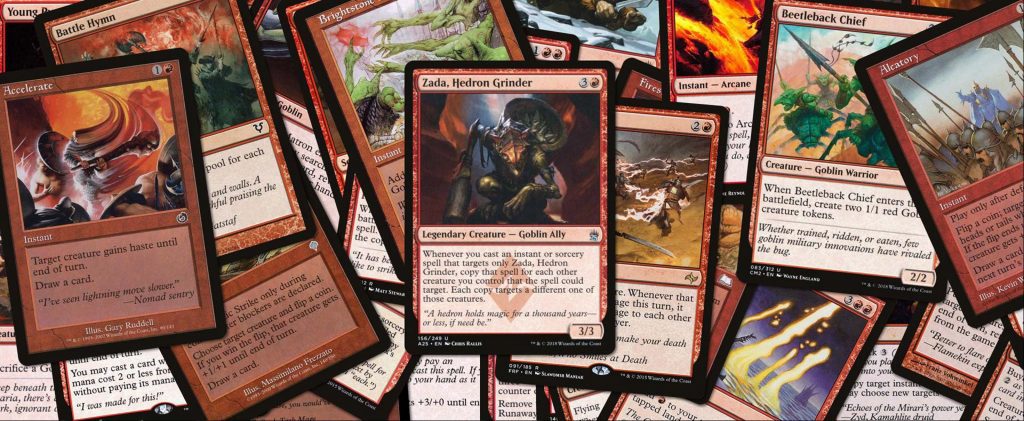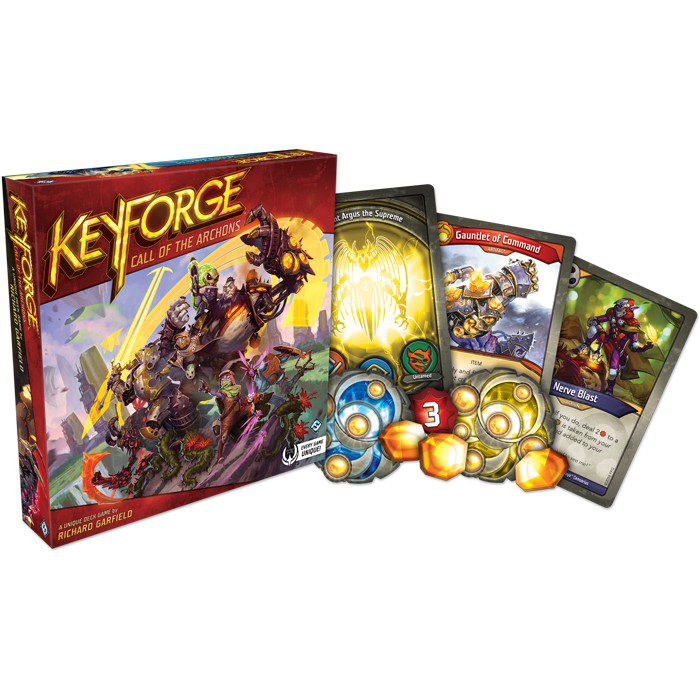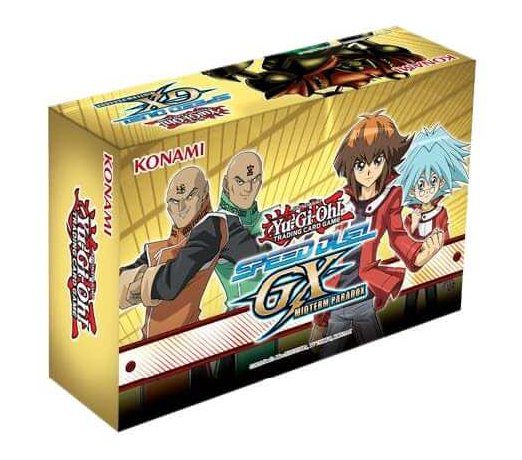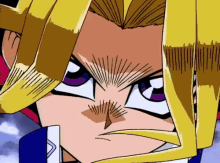
It would come as no surprise to anyone to learn Magic: the Gathering is my favourite game. I play it, think about it, and invest in it more than any other game I've ever encountered. It gives me more than any game could: a deep satisfaction in learning its rules, a form of creative expression in deckbuilding, and a play environment that's both challenging and robust. The settings in its multiverse are rich and varied, brought to life by some of the most evocative art in the business. And with so many formats - from Standard, to Commander, to Modern, to Legacy - any kind of player can find the game that fits them. Magic as a game is truly incredible. But all that said, I wouldn't recommend it to everyone.
It was that catch that sparked the idea for this article. Though I do think it's outstanding in its field, Magic isn't lightning in a bottle. There a plenty of card games that use "battle" as their thematic and mechanical thrusts. Such games usually involve two or more players fighting to be the last one standing, which they do by depleting an opponents' resource to zero. (In Magic's case, this resource is "life." If I, as a player, lose all my life, I lose the game.) I don't know what genre these games officially fall under, but I like to group them together as "card-fighting games." So while I wouldn't recommend Magic to everyone, I would heartily recommend card-fighting to everyone. It's fun, it's compelling, and in some cases it's surprisingly easy. In this article, I've compounded five games that I think could be worth your while.
Let's start the tour...
Accessibility: High
Complexity: Low
Financial Investment: Low
 If you've never played a card-fighting game but want to give it a try, I cannot recommend Star Realms more. For my money, its accessibility is unrivalled. And with a ruleset that's both easy to learn and fun to master, you'd be hard-pressed finding a better entry point. In a game of Star Realms, two or more players each start with an identical set of cards and 50 Authority. On our turn, we're going to be playing cards from our hand to either damage our opponents Authority or add cards to our deck by purchasing them from a common marketplace. Each card we buy is going to belong to one of four space-faring factions:
If you've never played a card-fighting game but want to give it a try, I cannot recommend Star Realms more. For my money, its accessibility is unrivalled. And with a ruleset that's both easy to learn and fun to master, you'd be hard-pressed finding a better entry point. In a game of Star Realms, two or more players each start with an identical set of cards and 50 Authority. On our turn, we're going to be playing cards from our hand to either damage our opponents Authority or add cards to our deck by purchasing them from a common marketplace. Each card we buy is going to belong to one of four space-faring factions:
- The Trade Federation generates big money, and are the only faction that can reliably replenish Authority.
- The Star Empire have consistent sources of damage, and excel at drawing you cards while denying cards from your opponents.
- The Machine Cult are great at turning your unwanted cards into money or damage, and play a good defensive game.
- The Blob are raw damage-dealers, capable of throwing haymaker after haymaker.
The factions are cartoonish, but they do a great job of giving identity to the different play archetypes within the game. They also fill the game world with life, and enable players to tell stories. In one round, the Blob and the Trade Federation may team up to destroy the Machine Cult, while in the next the Blob might defect, forcing the Trade Federation to find new allies in the Star Empire.
With such a solid foundation, Star Realms is unbelievably fun and endlessly replayable. And with a plethora of expansions in existence, it's easy to build on your experience with it. And for those of you who prefer fantasy to science-fiction, Hero Realms is essentially the same game, just in a swords-and-sorcery setting.
Accessibility: High
Complexity: Low
Financial Investment: Moderate - High
 Pokemon takes the famous battling from the video games and anime and lovingly recreates it in card form. Kids usually just collect the cards, but I think it'd be a rewarding endeavor to teach them how to play the game.
Pokemon takes the famous battling from the video games and anime and lovingly recreates it in card form. Kids usually just collect the cards, but I think it'd be a rewarding endeavor to teach them how to play the game.
Fundamentally, it's quite simple: each player has a deck of 60 cards, filled with Pokemon, Energy, Items, and Trainers. At the beginning of the game players shuffle their decks, draw a hand of seven cards, then set aside six cards from the top of their deck as "prize cards." Each time you knock out an opponents Pokemon, you take one of these prize cards - take all six to win the game! On a player's turn they'll be playing and evolving their Pokemon, equipping them with energy, attacking, and using item and trainer cards to get the edge. The game only involves some light mathematics, so it can be taught to young kids, and you'll find that the strategy involved will get deeper and richer the more you play.
Like most trading card games, Pokemon is limited only by the breadth of your creativity. You have a massive and ever-growing pool of cards to choose from when it comes to deck construction, which makes playing the game with a deck of your own feel personal and satisfying. As a franchise, Pokemon has a huge variety of colourful characters - ask a hundred people who their favourite Pokemon is and you'll likely get a hundred different answers - and all of them have been represented somewhere in the card game.
Pokemon's only pitfall is the pitfall shared by all trading card games; new batches of cards are released regularly, so staying current requires something of a financial commitment. The upside of this is that you are investing in a game that is forever changing and growing. There's an excitement involved with cracking new packs when they come out, a sense of discovery as you learn what the cards in this new set are. It's cool, but it can be expensive, so if money is an issue for you, you may have to temper your excitement with reason.
Accessibility: High
Complexity: Low - Moderate
Financial Investment: Low - Moderate
 Keyforge is the card-fighting game for people who just want a casual relationship with card-fighting games. In it, two players race to collect Aember and forge the three keys they need to win the game, using their own unique deck to do so. On a player's turn they will name one of the three suits that make up cards in their deck, and then they are free to play and use any cards in their hand or on the battlefield that match that suit. (This typically involves collecting Aember, casting spells, and attacking your opponents creatures.) Once they've done all they want to do, they draw back up to six cards, and the turn passes to their opponent. Progression of play is very straightforward, with a few extra fun and goofy rules printed on the cards themselves.
Keyforge is the card-fighting game for people who just want a casual relationship with card-fighting games. In it, two players race to collect Aember and forge the three keys they need to win the game, using their own unique deck to do so. On a player's turn they will name one of the three suits that make up cards in their deck, and then they are free to play and use any cards in their hand or on the battlefield that match that suit. (This typically involves collecting Aember, casting spells, and attacking your opponents creatures.) Once they've done all they want to do, they draw back up to six cards, and the turn passes to their opponent. Progression of play is very straightforward, with a few extra fun and goofy rules printed on the cards themselves.
What sets Keyforge apart from other card-fighting games is that there is no deckbuilding whatsoever. Each deck you buy is locked in; you cannot combine it with other decks you own or switch out any of the cards. What you buy is what you get, and in some instances what you get can be really good, whereas in others it can be atrocious. What you get is this slot machine of a game where you pull the lever and see how it goes. What you get is this journey of discovery as you and your friends navigate the random nature of the games triumphs and shortcomings. For a lot of people, these things are part of Keyforge's charm. But it's also why the game is so polarising.
Full disclosure: I don't like Keyforge. A big part of my enjoyment in card-fighting games comes from interactivity, from building a deck of my own from the pieces I'm given. To me, Keyforge feels static by comparison. I don't get to build a deck. My only involvement in the game is on my turn. But - and this is a BIG but - Keyforge isn't for me.
Keyforge is for people who get a kick out of novelty. It's for people who find joy in that randomness, for people who don't want to spend hours of their life turning it over in their heads. In a game like Magic, if your deck is bad, that's on you. In Keyforge, if your deck is bad, you're totally exempt from blame. You can laugh about how bad it is and just try your luck with another one. Ultimately, if a light, easy, quirky, random game sounds appealing to you, you might really enjoy what Keyforge has to offer.
Accessibility: Moderate
Complexity: Moderate - High
Financial Investment: Moderate - High
 Yu-Gi-Oh seems to be on the come-up in Melbourne at the moment. More and more unique faces are coming through the shop in search of cards, and it's great to see. Personally, Yu-Gi-Oh was the first card-fighting game that I properly invested in, understood, and played. As a kid, my mates and I would often spend our lunch breaks playing the game. Even in high school, a friend and I would play online when we should've been paying attention in class.
Yu-Gi-Oh seems to be on the come-up in Melbourne at the moment. More and more unique faces are coming through the shop in search of cards, and it's great to see. Personally, Yu-Gi-Oh was the first card-fighting game that I properly invested in, understood, and played. As a kid, my mates and I would often spend our lunch breaks playing the game. Even in high school, a friend and I would play online when we should've been paying attention in class.
Hailing from Japan, Yu-Gi-Oh helped pioneer the tried and true card-fighting formula. Each player starts with 8000 life points, and will summon monsters, cast spells, and lay traps in order to reduce their opponents life points to 0. Yu-Gi-Oh's field is set, so managing space is something you shouldn't forget. You can only have up to five monsters on your side of the field at a time, and the same is true for spells and traps. Unlike games like Magic or Pokemon where you use mana or energy to fuel your plays, Yu-Gi-Oh puts all the impetus on monsters. There's a boggling number of ways to turn your monsters into bigger, scarier monsters, and your ability to take games may hinge on how effectively you can do this.
With each generation of Yu-Gi-Oh, new mechanics are introduced that often involve new ways of summoning monsters. For a while these mechanics made the games faster and faster, while recently some work has been put into slowing the game down a bit. The game is highly competitive, and, in my experience, brings out a challenger's spirit in everyone who plays it. I got a lot of mileage out of Yu-Gi-Oh, so there's a decent chance you will too. In my case, it was superseded by something I found much more extraordinary.
Accessibility: Moderate
Complexity: Moderate - High
Financial Investment: Moderate - High
At the top of this article I said I wouldn't recommend Magic to everyone, so I know this is a little cheeky, but I couldn't talk about card-fighting without dedicating a section to my one true love.
I've already spoken about why I love Magic in this article, and in articles to come you'll hear similar sentiments. That being the case, I'm going to talk about the two formats I get the most out of within the game: Draft and Commander.
 Draft is a janky mess, but it's a fun janky mess. To play a game of Draft all you need is your merry self, a one-to-three friends, three Magic booster packs each, and a bank of land cards. The first step of playing involves building your deck; each player will open one of their booster packs, read through all the cards, pick one to keep, and then pass the rest clockwise. We all do this until there are no cards left to choose from, at which point we'll open the next booster pack and do it all again. Once we're out of boosters, each player will have 45 cards they can choose from to assemble a 40-card deck. Once the decks are built, we play! Draft is perhaps the "fairest" way to play Magic, as all players are pulling from the same limited pool of cards. The decks you make in draft will probably be pretty weak, but everyone is building a weak deck. Putting together the puzzle and seeing what ridiculous synergies you can find is a big part of what makes Draft fun.
Draft is a janky mess, but it's a fun janky mess. To play a game of Draft all you need is your merry self, a one-to-three friends, three Magic booster packs each, and a bank of land cards. The first step of playing involves building your deck; each player will open one of their booster packs, read through all the cards, pick one to keep, and then pass the rest clockwise. We all do this until there are no cards left to choose from, at which point we'll open the next booster pack and do it all again. Once we're out of boosters, each player will have 45 cards they can choose from to assemble a 40-card deck. Once the decks are built, we play! Draft is perhaps the "fairest" way to play Magic, as all players are pulling from the same limited pool of cards. The decks you make in draft will probably be pretty weak, but everyone is building a weak deck. Putting together the puzzle and seeing what ridiculous synergies you can find is a big part of what makes Draft fun.
Commander, on the other hand, is a lot grander in scale. 100-card decks, huge life totals, splashy spells - it's a no holds barred slugfest where the best way to play the cards is to sometimes play the player. In Commander, you'll pick one of the many Legendary Creatures from Magic's history and build a deck with only that creatures' colours. But keep in mind that you can only have a single copy of a card in your deck, so in those 100 cards you're going to see a lot of variety. Building decks with these restrictions is wonderfully fun, and - to me - is the ultimate way to express yourself creatively in the game. And the games themselves... Whoa! It's... kind of hard to explain if you're not already a Magic player. There are plenty of places you can watch Commander gameplay on line, but the most well-produced and family-friendly option can be found here.
Magic's a big game. If the scope of a trading card game frightens you, the designers of Star Realms have also made a game called Epic, which is envisioned as "a trading card game in a box."

Phew... Finally, we got there. I hope you've learned a little something about this genre I call "card-fighting," and I hope you've come away from it with an interest in trying it. This is the longest article I've written for the site; the next one won't get so long in the tooth. But, if you made it this far, thanks for your time. And until next we meet, stay safe, have fun, and play games!




